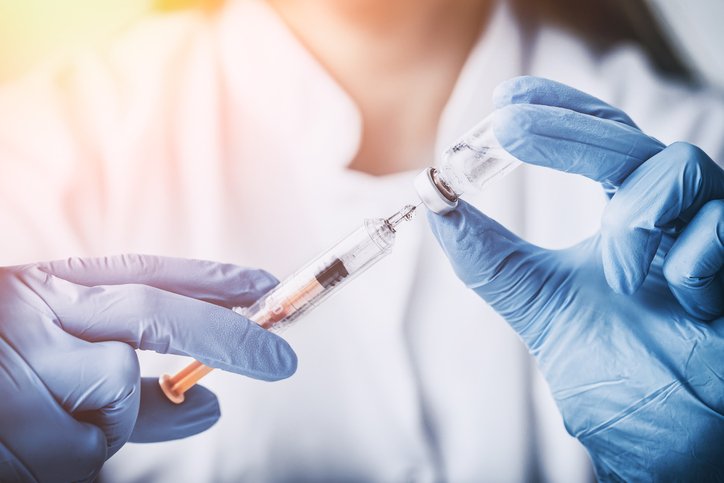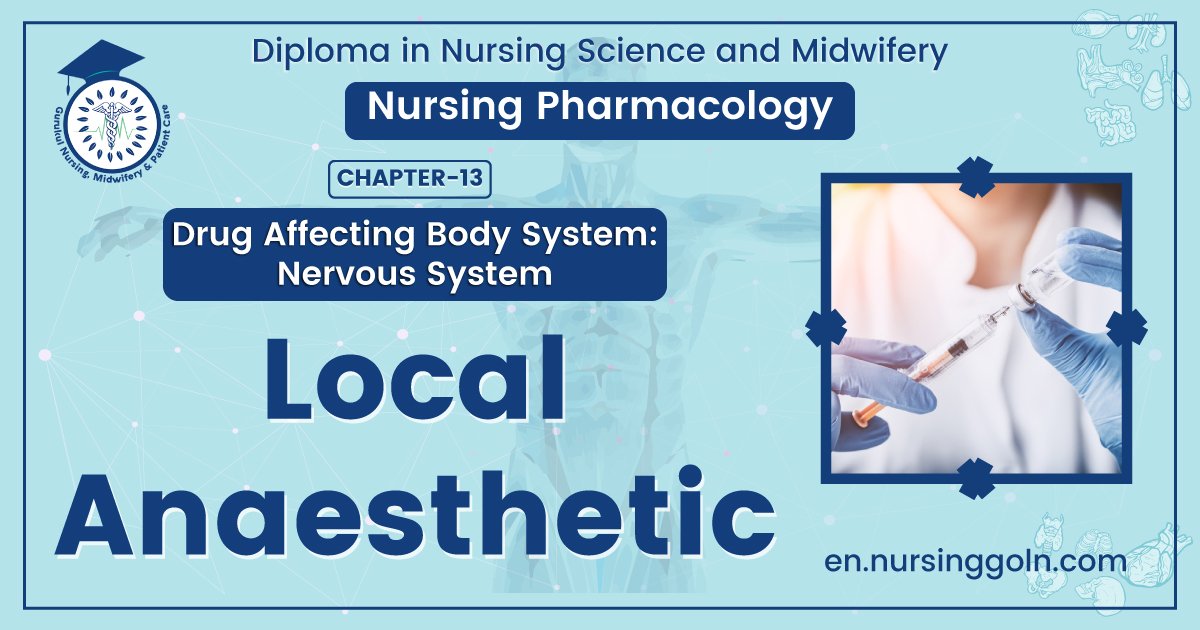Local Anaesthetics – This book covers the entire syllabus of “Pharmacology” prescribed by BNMC- for diploma in nursing science & midwifery students. We tried to accommodate the latest information and topics. This book is an examination setup according to the teachers’ lectures and examination questions.
At the end of the book, previous questions are given. We hope in touch with the book students’ knowledge will be upgraded and flourish. The unique way of presentation may make your reading of the book a pleasurable experience.
Local Anaesthetics
Local anaesthetics are the agents which are used for producing transient & reversible loss of sensation in a circumscribed area (localised area) without affecting the degree of consciousness. The molecules of local anaesthetics consist of an aromatic part linked by an ester or amide bond to a basic side chain. They are weak bases (except benzocaine) and are incompletely ionized at physiological PH.
Criteria of an ideal local anaesthetic:
It should not:
- Be irritating to the tissue which it is applied.
- Cause necrosis, sloughing, damage and ulceration of the surrounding tissues.
- Produce permanent damage to the nerve tissue.
- Produce systemic adverse reaction and local after effect. o Less potent and
- Change the PH of the environment.

It should be:
- Effective in whichever route it is given.
- Water soluble and sterilized by heat.
- Rapid onset of action (as short as possible)
- Effective in body PH.
- Cheap and available
- Sufficient in duration (so that the stipulated surgeon can finish operation).
- Xylocaine is nearly an ideal (safest and best) local anaesthetic.
Classification of local anaesthetics
➤ According to the duration of action:
a. Short acting (30 to 60 minutes)
1. Procaine (30 min)
2. Amethocaine (1 hour)
b. Intermediate acting (60 to 120 minutes)
1.Lidocaine (lignocaine, xylocaine 1-1.5 hr)
2. Articaine
3. Pilocaine (2 hours)
4. Mepivacaine
c. Long acting (>2 hours)
1. Bupivacaine (3 hours)
2. Tetracaine
3. Etidocaine
4. Dibucaine (3 hours)
B. According to chemical structure:
a. Ester group:
1. Procaine
2. Cocaine
3. Tetracaine
4. Benzocaine
b. Amide group:
1. Lidocaine
2. Bupivacaine
3. Prilocaine
4. Etidocaine
C. According to the clinical use:
a. Surface anaesthesia:
1.Lignocaine
2. Cocaine
3. Ethylchloride
Indication: Epistaxis Catheterization
b. Infiltration anaesthesia:
1. Lignocaine
2. Cocaine
3. Procaine
Indication: Minor surgery: Excision of lypoma, cyst Amputation Biopsy from growth
c. Nerve block anaesthesia
1. Lignocaine
2. Procaine
3. Tetracaine
Indication: Dentistry, Surgery in extremities
d. Spinal anaesthesia:
1. Lignocaine
2. Procaine
3. Tetracaine
Indication: Surgery in lower limbs, Obstetrical operations. Urological operations. Hernia, hydrocele operation.
e. Epidural anaesthesia:
1. Lignocaine
2. Bupivacaine
3. Tetracaine
Indication:
1. Painless child birth
2. Surgery in lower limbs
3. Obstetrical operations.
4. Urological operations.
5. Hernia, hydrocele operation.
Mechanism of action of local anaesthetics
Local anaesthetics specifically act on voltage dependent Na channels and thereby block the initiation and propagation of action potentials. Non-specifically local anaesthetics also act on membranes by virtue of their surface activity.
Local anaesthetic
↓
Binds with the protein of the Na channels at inactivated stage (at the interior side)
↓
Block the voltage dependent Na+ conductance (i.e. prevent Na* influx)
↓
Block the depolarisation, so fails to initiation and propagation of action potentials.
↓
Afferent impulses (nociceptive) cannot go to the higher centre.
↓
No pain sensation
Pharmacological properties of Local anesthetics
A. Route of administration: Tropical, infiltration, r/v
B. Onset of action:
1. Slow onset: Amethocaine
2. Moderate onset: Procaine, Prilocaine
3. Rapid onset: Lignocaine.
C. Duration of action
1. Long acting: >2 hours
2. Intermediate: 60-120 minutes
3. Short acting: 30-60 minutes
D. Tissue penetration
1. Slow: Procaine,
2. Moderate: Prilocaine, Bupivacaine
3. Rapid: Lignocaine, (lidocaine)
E. Metabolism
1. Ester group: By plasma pseudocholinesterase
2. Amide group: In the liver.
Adverse effects (toxicities) of local anaesthetics:
A. On CNS: Euphoria (cocaine), Sleepiness, Visual and auditory disturbance, Nystagmus, shivering, convulsions, CNS depression leading to Respiratory depression and death.
B. On PNS: Neurotoxicity (sensory and motor deficits)
C. On CVS: Myocardial depression, Vasodilatation. Hypotension, Qunidine like action (antiarrhythmic), Hypertension (cocaine)
D. On blood: Methaemoglobinaemia
E. Allergic: Rash, asthma, anaphylactic shock.
Xylocaine
Lidocaine or Lignocaine
It is an ideal & most important local anaesthetic, because of
1. Rapid onset of action (within 2-5 min) and potent
2. Moderate duration of action (1/2-1 hour).
3. Penetrates tissue readily and effective in all routes.
4. Less toxic effect (especially in CNS).
5. It has anti-arrhythmic, anticonvulsive & anti-hypertensive effects.

Mechanism of action of xylocaine
It depresses the automaticity and depolarisation (Na+ channel blocker).
Indication of xylocaine
- As local anaesthetics
- As anti-arrhythmic drug
- As anti-convulsive drug.
Adverse effects of xylocaine
- Sleepiness
- Drowsiness
- Dizziness.
- Nausea
- Tremor
- Blurred vision
- Convulsion &
- Respiratory arrest
Contraindication of xylocaine
- A-V block
- Bradycardia
- Myasthenia gravis.
Pharmacological preparations
- Surface: Xylocaine jelly, sprays, ointment
- Parenteral: Without adrenaline 0.5, 1, 1.5, 2,4, 10, 20% inj.
- With adrenaline: 1, 2% with 1: 100,000 Ad

Cocaine
- It is an alkaloid of erythroxylon coca.
- Duration of action: medium
- Differ from other local anaesthetics in cardiovascular effects (vasoconstriction and hypertension).
- Pharmacological preparation: 4% cocaine (topical use).
Pharmacological action of Cocaine
A. Local anaesthetic effect: Block nerve conduction following local application.
B. On CNS: by stimulation of CNS it
✷Abolishes sense of fatigue and hunger.
✷Produces tremor, euphoria and excitement.
✷On medulla: increases respiratory rate. also stimulates VMC and CTZ.
C. On Eye: mydriasis, cycloplegia, loss of conjunctival and eyelid reflex, corneal anaesthesia, decrease IOP.
D. On CVS: elevates blood pressure and heart rate.
E. Body temperature markedly pyrogenic.

Toxicities of Cocaine
A. Acute poisoning:
- Restlessness
- Excitement
- Tremor
- Convulsion
b. In chronic poisoning:
- Emaciation
- Tremor
- Insanity
- Cocaine fever
- Mydriasis
- Blurred vision
- Hypotension
- Hallucination
- Addiction showing
- Homicidal tendency.
Indication of Cocaine
- Acts as surface anaesthesia.
- Minor surgical operation where loss of consciousness is not necessary As an adjuvant (in case of major surgery to avoid deep General anaesthesia).
- Ophthalmic and E.N.T surgery.
- Regional anaesthesia.
Treatment of acute Cocaine Poisoning
- Chlorpromazine
- Muscle relaxant (e.g. mephenesis)
- Artificial respiration
Read more:
